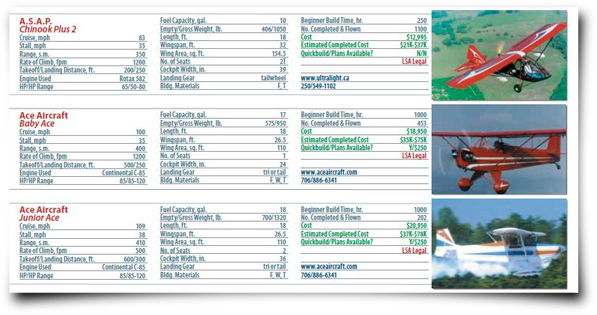It’s that time of year again, the time when we undertake the arduous task of updating and compiling the thousands of pieces of data that go into our annual Buyer’s Guides. The process has been described in these pages before, and involves contacting every kit, plans or rotorcraft manufacturer from the previous year (plus any new companies we’ve become aware of) to ask what has changed. Oftentimes, as you would expect, the items subject to revision are number sold and prices. Barring any significant changes to the design, the specifications should be well established, so typically the majority of the data remains the same from year to year. Even so, the verification process is conducted, and it allows us to provide you with information that is not available elsewhere.

Which brings us to a question of form. For several years we have been examining new approaches to presenting this information in the most useful and valuable manner. With the growth of the Internet over the last 15 years, more and more people are consuming media in new ways, from how we get news to how we listen to music to how and when we watch movies or television. So it stands to reason that we would seek to enhance the online version of the Buyer’s Guide, paired with a differently conceived counterpart in the magazine that highlights changes, new designs and trends. A dynamic version of online data, given a suitable platform and support, would yield much more useful search results and allow us to update the information as it becomes available rather than just once a year. The problem is that any database structure created years ago is bound to outgrow its original purpose, and we’ve been working around those inherited limitations ever since.
The reasons for considering such changes are clear. Most manufacturers have an informational web site where potential buyers can read to their heart’s content about a design of their choice. Also, changing the format in the magazine would allow us to call attention to what is noteworthy, and to group statistics and profiles in a meaningful way, with more flexibility to tailor the presentation of the material to the material being presented.
We are looking at ways to make the annual Aircraft Buyer’s Guides more useful to readers. One idea is to have a feature in the magazine that would highlight new designs, developments and trends, coupled with improved Buyer’s Guide data online, but without including the full Buyer’s Guide in the printed version.
[polldaddy poll=5595593]
As it stands now, our data presentation in the magazine is impractically constrictive: one design, one listing, giving the appearance that all designs are created equal. In some ways, this is misleading. Each kit gets equivalent attention, whether the company has sold 500 kits or five over the past decade. One must really dig to get the details. There’s no room to call attention to new designs, or those with new features or significant updates. Nor can we group various designs in a way that makes sense to buyers. Yet, as a monthly magazine, providing analysis and context is part of our core mission. Presenting the data in a different format in the magazine, supplemented by improved data online (in a reasonable and accessible form), would allow us to point out some of the disparities and contrasts. This is not to say that each viable company should not be included in a comprehensive Buyer’s Guide, but rather in what form?
So, we would like to hear from you, the readers we serve. How can we make the Buyer’s Guides more valuable to you? I’ve heard opinions across the spectrum, one subscriber (a current builder) saying that when he used to pick up the magazine on the newsstand, he’d put the Buyer’s Guides back because they were of no interest to him. Other readers have argued vehemently that the Buyer’s Guides are some of their favorite issues, and they don’t want to be forced to go online to look for more information. Where do you stand?
Again, our intention is not to do away with the Buyer’s Guides, but merely to leverage the current technology and various platforms available to us to improve the presentation of information. Change is inevitable. (I recently heard someone say that if Shakespeare were writing today, he wouldn’t use a quill.) A clean, web-based data set would provide myriad options. For example, say that you conducted a search for a given type of aircraft, and the result included four designs that fit your criteria. Given the large amount of archival material on our web site, we could link to past flight reviews or perhaps a related video. We could add links to manufacturer web sites, making it easy to access their information from a search result (and see how it differs). The possibilities are endless, and the value of current information available year-round cannot be overestimated for serious buyers.
That’s our perspective. We’d like to hear from you—both the vocal minority and the seemingly silent majority alike. Let us know what you think.




